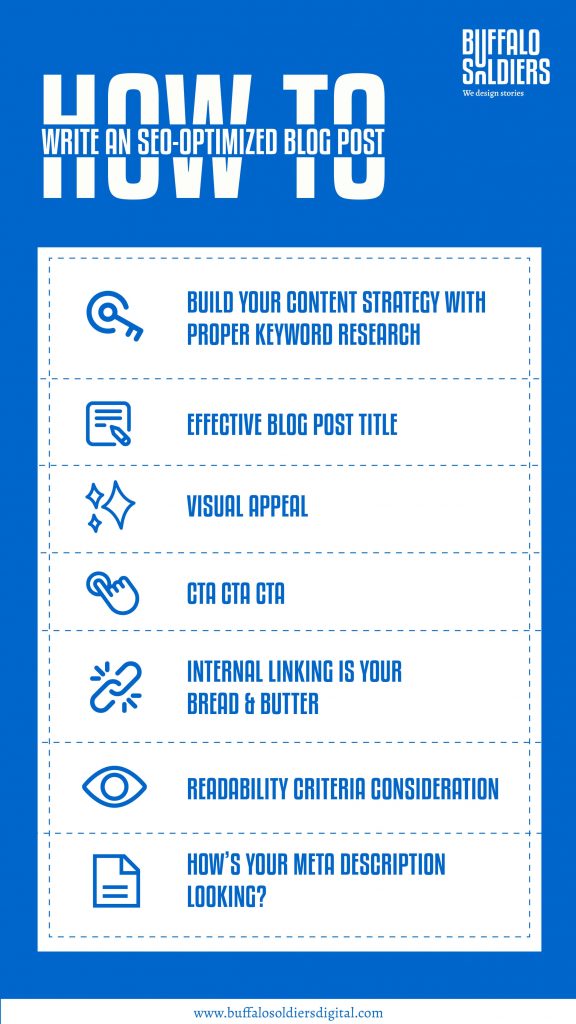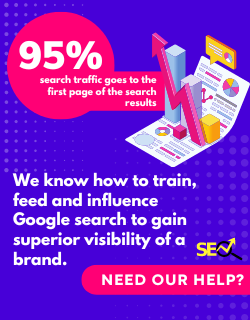There is a saying our great CEO repeats almost every other day – “If you are on the second page of Google, you are as good as buried. You know that.” Impactful right? Still, this is not as impactful as what SEO can do for you and your brand if you aptly optimize it in your blog posts.
For marketers, SEO, or search engine optimization, is crucial. When you optimize your web pages, including your blog entries, you boost your website’s exposure to people who use search engines (such as Google) to find your product or service.
While focusing on how to write an SEO-optimized blog post, Many bloggers fail to capitalize on their blogs’ enormous commercial potential. By supplying new, relevant content and doing basic blog post optimization.
Although it is evident that blog content helps with SEO, Google’s regular algorithm changes may make producing the right sort of blog content challenging if you don’t know where to start. Some blog ranking factors have weathered the test of time, while others are considered “outdated.”
But what is all this noise around blogs and its relevant impact on SEO? Let’s take a look.
The Benefits of Business Blogging
If you’re not aware of business blogging and how it might benefit your organization, here are some quick points to consider:
- Blog posts will drive more visitors to your company’s website, resulting in more leads.
- Blogging helps you to establish links, which improves your search engine rankings.
- Content from your blog may be repurposed on your Google My Business page and social media platforms.
- The long-term benefits of blog entries for website traffic.
- Blog entries are the most effective type of information (above email, ebooks, and white papers).
If you operate a small to medium-sized business, you can’t afford to miss out on this easy way to boost traffic and interest in your website!
Also Read: How To Create an Effective SEO Strategy To Generate The Best ROI
How To Write An SEO-Optimized Blog Post

- Build Your Content Strategy with Proper Keyword Research
Keyword research is essential for on-page SEO. By providing relevant knowledge on a topic, you may be including keywords without even realizing it. You don’t have to rely on informed guesses, especially when keyword research can tell you precisely what your customers want.
After determining your target demographic and creating a buyer persona, it’s time to figure out what material your readers want to consume.
You may use these keywords to create a content strategy. It guarantees that you write about topics people are interested in, which is an excellent way to build an engaged audience.
In terms of SEO best practices for blog posts – this ranks as high as one could.
- Effective Blog Post Title
The title of your blog post is the first thing a reader sees when they encounter your material, and it has a significant impact on whether they click or scroll down. A catchy title draws the reader in by employing facts, asking a question, or beginning with interest.
To make your blog piece more SEO-friendly – include your core keyword in the title. We advocate making your title snappy and click-worthy in addition to containing your primary keyword. It is because your organic click-through rate (CTR) is of utmost importance in SEO.
- Visual Appeal
The visual language of your content holds high precedence. Especially in cases of SEO best practices for blog posts, images play a vital role.
Including photographs and videos in your blog posts increases visitor engagement and interest. Reader-friendly content is more likely to rank higher in search results.
Read More: What is Branding and Why is it Important for Your Business
- CTA CTA CTA
A blog post with no Call To Action button is just as good as a bar with no alcohol – NO BLEEPING POINT.
The goal of a CTA is to guide your user to the next step in their journey via your blog post. A great CTA is related to the topic of your existing blog post and flows naturally with the rest of the content. Every blog article you publish will require a compelling CTA, whether you’re pushing a newsletter, subscription selling a product, or simply wanting the reader to consume more of your content.

- Internal Linking Is Your Bread & Butter
After a while in your blogging journey, you have enough resources or source material to interlink with your current blog post.
Internal linking is a fantastic way to create a contextual relationship between new and old articles. You can also route relevant link juice to older articles.
WordPress makes it easy to access previous posts immediately within the post editor. Select the text to connect and press the link button.
- Readability Criteria Consideration
Ask yourself this question – would you want to read a blog post with tacky readability with information all over the place? If yes, then what’s wrong with you?
Your primary concern as a writer is to enhance the experience of the reader and ensure the flow of information is fluid for them.
The use of headers and subheadings in the content body is also consequential since it helps the reader to quickly scan the material to find the information they want. Finally, on-page elements such as images and videos have an impact on page performance.
In terms of SEO best practices for blog posts, readability is a severely underrated commodity.
- How’s Your Meta Description Looking?
The meta description is an HTML meta tag that may be used on any page. Its goal is to provide a concise overview of your article to search engines and other crawlers.
According to top SEO experts, the meta description element is no longer relevant. Many others, on the other hand, might disagree.
A good meta description may reveal a lot more about an article. It is also displayed when your material gets shared on social networking sites such as LinkedIn, Twitter, and Facebook.
And Therefore…
To cut it short – you need to create blog content that your readers will LOVE. Okay, there is slight addition we’d like to make here. Create blog content that your readers and the search engine will LOVE. Yes, that’s the sweet spot.
However, as your website grows in size, so should your search engine optimization objectives. You’ll be on track to develop relevant content that will climb the SERP ranks once you’ve established your target readers’ objectives and purpose.
So, what’s your next step? You’re all pumped up to prove yourself and know how to write an SEO-optimized blog post, but can you implement all these factors consistently and incredibly?
Here’s where we come in. We are Buffalo Soldiers – a Premium Search Engine Optimization Company in India. Our top SEO experts are one of the best in the country, and they revel in taking on challenges that others would shrug at with confusion.
The services we provide in the SEO domain are, but are not limited to:
- Technical SEO Audit Services
- On-Page SEO
- Off-Page SEO
- Keyword Research Services
- SEO Content Writing
- Link Building Services
Our track record speaks for itself, and we ensure that no stone remains unturned. We go all the way for you and your brand. Reach out to us, we provide a free consultation, and we will help you curate a plan for the SEO services needed for your business.


